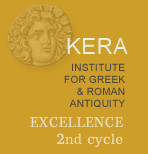Main Site . İbecik
5 10 |
κα̣λῶ̣[ς ζήσας] κὲ θανὼν̣ Δάφνος κηπουρῶν̣ ἄριστος τὸ ἡρῷον ἑαυτῷ̣ κατε– σκεύασεν κὲ μετὰ τὸ πολ– λὰ κοπιάσαι· ταῦτα. |
After a good life and death8, Daphnos the best of gardeners has raised this monument for himself, having worked hard. That's it.
Rectangular altar, found and documented by Kalinka in 1895 in a house in İbecik.
Height: 70 cm; length: 26 cm; depth: 14 cm; letters: 2-4 cm.
Heberdey and Kalinka 1897, p. 41, no. 59; Schindler 1972, no. 36; BullÉp 1973, no. 463; Milner 1998, p. 4, no. 2.11.
L. 1 : BullÉp 1973, no. 463, corrects the restoration καλῶ̣[ς ζῶν] supplied by Heberdey and Kalinka and followed by Schindler. Of course the past participle ζήσας makes more sense in this context, as Daphnos could not possibly have been alive (ζῶν) and dead (θανών) at the same time. Moreover, the expression καλῶ̣ς ζήσας or βιώσας is attested elsewhere; cf. i.a. IG X, 2.1 461; 722; 774 (Macedonia); IG II² 12753 (Attica); IG XII, 7 347; 374 (Amorgos); TAM V 122 (Lydia).
L. 3-5 : Δάφνος appears to be the most popular one among the male names derived from δάφνη, laurel. It is attested once in Cibyra: IK Kibyra I 163 (owned by a slave). Gardener is among the occupational categories that appear rather often in inscriptions; see the comments by Robert, (op. cit.), and BullÉp 1971, no. 648; cf. Corsten, in IK Kibyra I, p. 98, on an inscription (no. 64) set up by the "πρὸς πόλιν κηπουροί οἰκοῦντες", the gardeners that reside by the city. Generally on craftsmen and professional guilds in the Greek East see van Nijf 1997; Dittmann-Schöne 2001; Zimmermann 2002; Harland 2003. See also the database Antike Berufsvereine provided by the Römisch-Germanisches Zentralmuseum. On the gardens of İbecik/Boubon see Collignon 1897, pp. 11f. (cited and quoted in BullÉp 1973, no. 463).
The expression κηπουρῶν ἄριστος evokes the language of Homer's heroic world and maybe the agonistic title ἄριστος Ἑλλήνων; cf. van Nijf, (op. cit.), 40-41 with note 43.
L. 9-11 : Πολλὰ κοπιάω is an expression that appears in late authors and survives in a similar form in modern Greek. It may have been formed by analogy with πολλὰ μοχθῶ (attested already in Aristophanes and Euripides). In contrast to the verb μοχθέω however, κοπιάω with the accusative is not in accordance with classical grammar.
Though Daphnos is proud of his life's work, and boasts of having been a good gardener, there is also a tone of resignation in the epigram he chose for his tomb. Its last lines imply a lonely life's struggle and a stoical if not cynical attitude to death as that life's conclusion. Through hard labour, he was able to raise this monument for himself. The concluding word ταῦτα is a variation of expressions that appear in other epitaphs, for example ὁ βίος ταῦτα or ὁ βίος οὗτος, meaning "that's life" or "that is how life is"; cf. i.a. EpigrAnat 11 (1988), p. 141, no. 76 (Perge, Pamphylia); SEG 19 (1963), no. 808 (Hadrianoi, Pisidia); Studia Pontica III 263 (Zela, Pontus); MAMA 7 338 and 477 (both Galatia). IG XII, 7 126 from Amorgos provides a lucid example: [τ]ῷ μὲν μοῖρα | δέδωκε τὸ γῆρας, | τῷ δ’ ἔτι <καλόν> | καὶ νέον | ὄντα θανεῖν· οὕτως ὁ βίος δεδί|[κασ]ται. | ἡ κλέος ἀρα|[μέν]η [εἵ]ν[ε]κα σωφρ[ο]|[σ]ύνης | Ὀνησίμη | Φένγοντος ἐτῶν |τεσσαράκοντα. To one (man) destiny gave old age; to another, death while he was still beautiful and young. That's how life has been ordered. Onesime, daughter of Phengon, forty years of age, who reaped fame for her prudence.
Like our inscription from Boubon, TAM IV, 1 336 from Nicomedeia in Bithynia concludes with a dry ταῦτα, but an apostrophe addressing the reader is added: εὔφρενε (εὔφραινε) σαυτόν, enjoy yourself.

